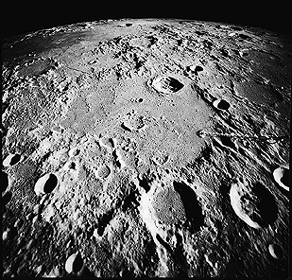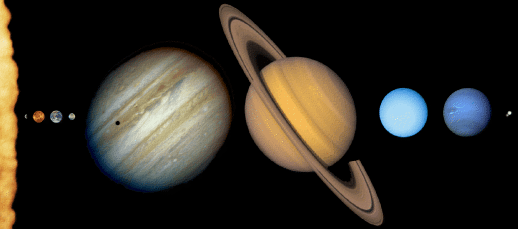Formation of the Planets
Planets can apparently form quite naturally and commonly from the
"leftover" material of star formation. Studies of the planets in our
solar system, chemistry of meteorites, comets, and material around
young stars, leads to the following sequence of events.
Material in the disk consists mostly of hydrogen and helium,
with a small fraction of small dust grains. These came, in part,
from the atmospheres of previous giant stars and supernova remnants.
These solid particles can stick together (agglomeration)
if they bump slowly enough, leading to a population of slowly growing
solid objects. Some of these planetesimals may still be seen as
long-period comets.
 Eventually some of these planetesimals will become large enough for their
own gravitation to accelerate their growth, increasing the number of
particles joining the clump. This is accretion. Viewed
in this way, the 1994 impact of Comet Shoemaker-Levy 9 into Jupiter
was just a particularly late phase in the planet's formation.
The last stages of this buildup are known as the prompt
initial bombardment, as most of the loose debris hits bigger
objects. Lunar craters, for example, represent the final impacts. The Earth's
crust would
have been repeatedly melted by the largest impacts in this period,
which has been used to estimate the timescale for life to appear.
One particularly large impact may be responsible for our having an
unusually large Moon for such a small planet.
Eventually some of these planetesimals will become large enough for their
own gravitation to accelerate their growth, increasing the number of
particles joining the clump. This is accretion. Viewed
in this way, the 1994 impact of Comet Shoemaker-Levy 9 into Jupiter
was just a particularly late phase in the planet's formation.
The last stages of this buildup are known as the prompt
initial bombardment, as most of the loose debris hits bigger
objects. Lunar craters, for example, represent the final impacts. The Earth's
crust would
have been repeatedly melted by the largest impacts in this period,
which has been used to estimate the timescale for life to appear.
One particularly large impact may be responsible for our having an
unusually large Moon for such a small planet.
The largest protoplanets can eventually attract not only solid particles
and heavy molecules, but gaseous atoms. The growth of these objects
is terminated when the young Sun is hot enough to blow a wind which
sweeps most of the interplanetary gas away. In other stars we
call this a T Tauri phase.
Planets' orbits may alter not only due to collisions with large
objects, but gravitational interaction with remaining disk gas.
If this goes on too long, the giant planets can migrate into
or close to the star (as has happened in many other systems).
This is thought to be unhealthy for terrestrial planets.
The planets we see now are the last objects left from this chain
of processes.

(This
composite image copyright
Calvin J. Hamilton)
The major categories of solid objects we see are
terrestrial planets (rocky, solid surfaces), giant planets (mostly
hydrogen and helium like the Sun, no solid surface), and
smaller debris (minor planets, comets, dust). The three largest
terrestrial worlds furnish powerful comparisons as to
atmosphere, climate, tectonics, and volcanic history.
The recent discovery of extrasolar planets by reflex Doppler motion
(view sample data plot)
has made it clear that planets are a normal accompaniment to
sunlike stars. There are now over 90 planets known around nearby
stars, mostly with masses comparable to Jupiter. Many of these
are "hot Jupiters" which have migrated within a few million km
of the star, probably precluding the existence of habitable
terrestrial planets in their systems. Jupiter is fine just where it is, thank
you very much...
More details:
California Extrasolar Planet Search
Views of the Solar System
keel@bildad.astr.ua.edu
Last changes: 8/2002
Planets can apparently form quite naturally and commonly from the
"leftover" material of star formation. Studies of the planets in our
solar system, chemistry of meteorites, comets, and material around
young stars, leads to the following sequence of events.
Material in the disk consists mostly of hydrogen and helium,
with a small fraction of small dust grains. These came, in part,
from the atmospheres of previous giant stars and supernova remnants.
These solid particles can stick together (agglomeration)
if they bump slowly enough, leading to a population of slowly growing
solid objects. Some of these planetesimals may still be seen as
long-period comets.
 Eventually some of these planetesimals will become large enough for their
own gravitation to accelerate their growth, increasing the number of
particles joining the clump. This is accretion. Viewed
in this way, the 1994 impact of Comet Shoemaker-Levy 9 into Jupiter
was just a particularly late phase in the planet's formation.
The last stages of this buildup are known as the prompt
initial bombardment, as most of the loose debris hits bigger
objects. Lunar craters, for example, represent the final impacts. The Earth's
crust would
have been repeatedly melted by the largest impacts in this period,
which has been used to estimate the timescale for life to appear.
One particularly large impact may be responsible for our having an
unusually large Moon for such a small planet.
Eventually some of these planetesimals will become large enough for their
own gravitation to accelerate their growth, increasing the number of
particles joining the clump. This is accretion. Viewed
in this way, the 1994 impact of Comet Shoemaker-Levy 9 into Jupiter
was just a particularly late phase in the planet's formation.
The last stages of this buildup are known as the prompt
initial bombardment, as most of the loose debris hits bigger
objects. Lunar craters, for example, represent the final impacts. The Earth's
crust would
have been repeatedly melted by the largest impacts in this period,
which has been used to estimate the timescale for life to appear.
One particularly large impact may be responsible for our having an
unusually large Moon for such a small planet.
The largest protoplanets can eventually attract not only solid particles
and heavy molecules, but gaseous atoms. The growth of these objects
is terminated when the young Sun is hot enough to blow a wind which
sweeps most of the interplanetary gas away. In other stars we
call this a T Tauri phase.
Planets' orbits may alter not only due to collisions with large
objects, but gravitational interaction with remaining disk gas.
If this goes on too long, the giant planets can migrate into
or close to the star (as has happened in many other systems).
This is thought to be unhealthy for terrestrial planets.
The planets we see now are the last objects left from this chain
of processes.

(This
composite image copyright
Calvin J. Hamilton)
The major categories of solid objects we see are
terrestrial planets (rocky, solid surfaces), giant planets (mostly
hydrogen and helium like the Sun, no solid surface), and
smaller debris (minor planets, comets, dust). The three largest
terrestrial worlds furnish powerful comparisons as to
atmosphere, climate, tectonics, and volcanic history.
The recent discovery of extrasolar planets by reflex Doppler motion
(view sample data plot)
has made it clear that planets are a normal accompaniment to
sunlike stars. There are now over 90 planets known around nearby
stars, mostly with masses comparable to Jupiter. Many of these
are "hot Jupiters" which have migrated within a few million km
of the star, probably precluding the existence of habitable
terrestrial planets in their systems. Jupiter is fine just where it is, thank
you very much...
Planets can apparently form quite naturally and commonly from the "leftover" material of star formation. Studies of the planets in our solar system, chemistry of meteorites, comets, and material around young stars, leads to the following sequence of events.
Material in the disk consists mostly of hydrogen and helium, with a small fraction of small dust grains. These came, in part, from the atmospheres of previous giant stars and supernova remnants. These solid particles can stick together (agglomeration) if they bump slowly enough, leading to a population of slowly growing solid objects. Some of these planetesimals may still be seen as long-period comets.
 Eventually some of these planetesimals will become large enough for their
own gravitation to accelerate their growth, increasing the number of
particles joining the clump. This is accretion. Viewed
in this way, the 1994 impact of Comet Shoemaker-Levy 9 into Jupiter
was just a particularly late phase in the planet's formation.
The last stages of this buildup are known as the prompt
initial bombardment, as most of the loose debris hits bigger
objects. Lunar craters, for example, represent the final impacts. The Earth's
crust would
have been repeatedly melted by the largest impacts in this period,
which has been used to estimate the timescale for life to appear.
One particularly large impact may be responsible for our having an
unusually large Moon for such a small planet.
Eventually some of these planetesimals will become large enough for their
own gravitation to accelerate their growth, increasing the number of
particles joining the clump. This is accretion. Viewed
in this way, the 1994 impact of Comet Shoemaker-Levy 9 into Jupiter
was just a particularly late phase in the planet's formation.
The last stages of this buildup are known as the prompt
initial bombardment, as most of the loose debris hits bigger
objects. Lunar craters, for example, represent the final impacts. The Earth's
crust would
have been repeatedly melted by the largest impacts in this period,
which has been used to estimate the timescale for life to appear.
One particularly large impact may be responsible for our having an
unusually large Moon for such a small planet.
Planets' orbits may alter not only due to collisions with large objects, but gravitational interaction with remaining disk gas. If this goes on too long, the giant planets can migrate into or close to the star (as has happened in many other systems). This is thought to be unhealthy for terrestrial planets. The planets we see now are the last objects left from this chain of processes.

(This composite image copyright Calvin J. Hamilton)
The major categories of solid objects we see are terrestrial planets (rocky, solid surfaces), giant planets (mostly hydrogen and helium like the Sun, no solid surface), and smaller debris (minor planets, comets, dust). The three largest terrestrial worlds furnish powerful comparisons as to atmosphere, climate, tectonics, and volcanic history.
The recent discovery of extrasolar planets by reflex Doppler motion (view sample data plot) has made it clear that planets are a normal accompaniment to sunlike stars. There are now over 90 planets known around nearby stars, mostly with masses comparable to Jupiter. Many of these are "hot Jupiters" which have migrated within a few million km of the star, probably precluding the existence of habitable terrestrial planets in their systems. Jupiter is fine just where it is, thank you very much...
More details:
keel@bildad.astr.ua.edu
Last changes: 8/2002